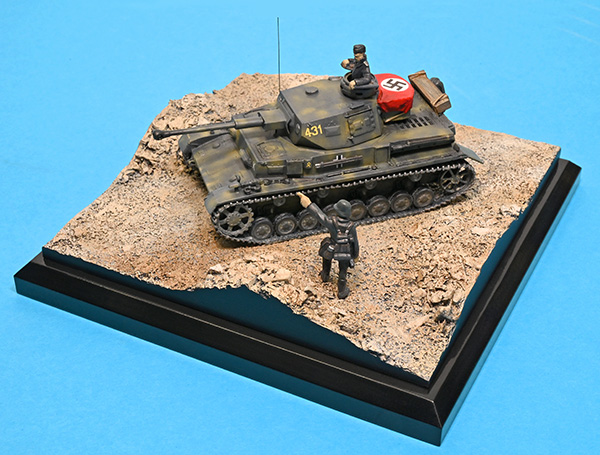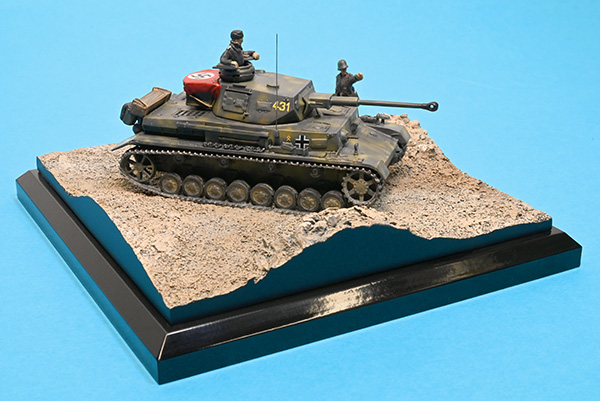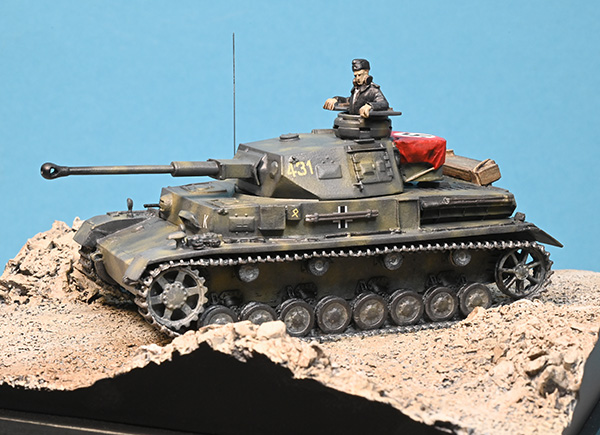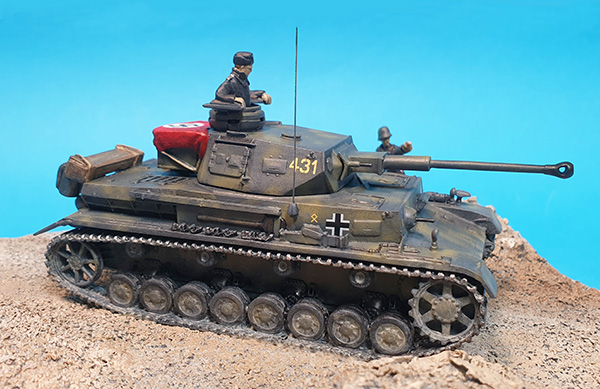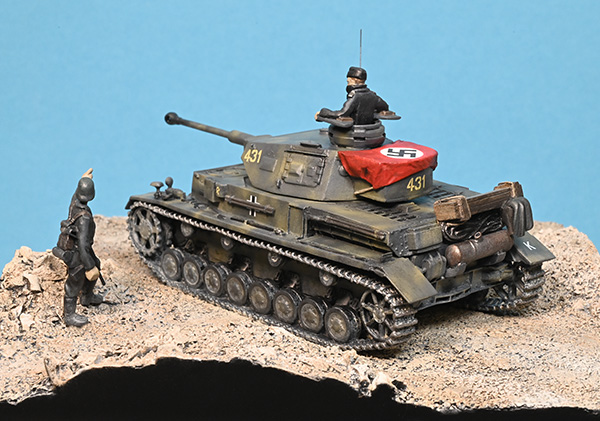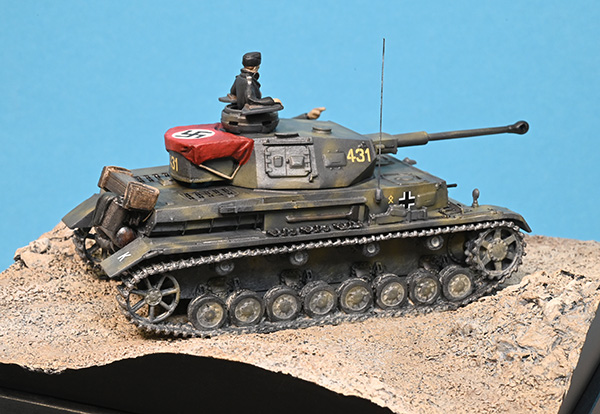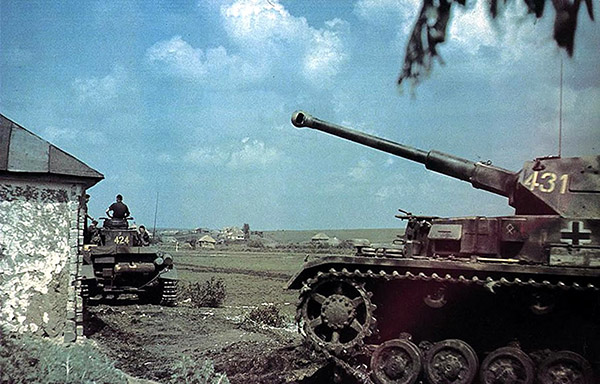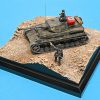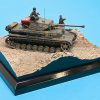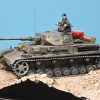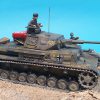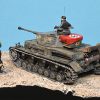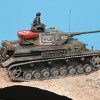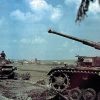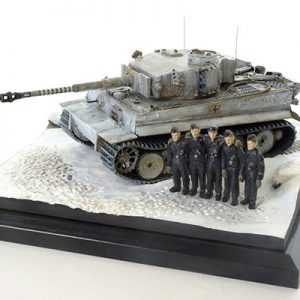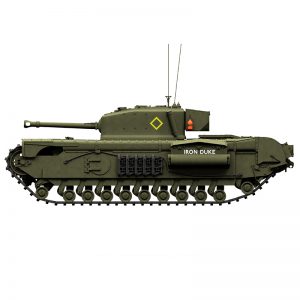Panzer IV Ausf. F2
Turmnummer ‘431’
4. Kompanie, II. Abteilung, Panzer Regiment 36, 14th Panzer Division
Eastern Front, Stalingrad, Summer 1942.
The Panzerkampfwagen IV was the brainchild of the German general and innovative armoured warfare theorist Heinz Guderian. In concept, it was intended to be a support tank for use against enemy anti-tank guns and fortifications. On 11 January 1934, the German army wrote the specifications for a “medium tractor”, and issued them to a number of defence companies. To support the Panzer III, which would be armed with a 37-millimetre (1.46 in) anti-tank gun, the new vehicle would have a short-barrelled, howitzer-like 75-millimetre (2.95 in) as its main gun, and was allotted a weight limit of 24 tonnes. Development was carried out under the name Begleitwagen (“accompanying vehicle”), or BW, to disguise its actual purpose, given that Germany was still theoretically bound by the Treaty of Versailles ban on tanks. MAN, Krupp, and Rheinmetall-Borsig each developed prototypes, with Krupp’s being selected for further development.
The chassis had originally been designed with a six-wheeled Schachtellaufwerk interleaved-road-wheel suspension, but the German Army amended this to a torsion bar system. Permitting greater vertical deflection of the road-wheels, this was intended to improve performance and crew comfort both on- and off-road. However, due to the urgent requirement for the new tank, neither proposal was adopted, and Krupp instead equipped it with a simple leaf spring double-bogie suspension, with eight rubber-rimmed road-wheels per side.
The prototype required a crew of five men; the hull contained the engine bay to the rear, with the driver and radio operator, who doubled as the hull machine gunner, seated at the front-left and front-right, respectively. In the turret, the tank commander sat beneath his roof hatch, while the gunner was situated to the left of the gun breech and the loader to the right. The turret was offset 66.5 mm (2.62 in) to the left of the chassis centre line, while the engine was moved 152.4 mm (6.00 in) to the right.
Accepted into service as the Versuchskraftfahrzeug 622 (Vs.Kfz. 622), production began in 1936 at Fried. Krupp Grusonwerk AG factory at Magdeburg.
On 26 May 1941, mere weeks before Operation Barbarossa, during a conference with Hitler, it was decided to improve the Panzer IV’s main armament. Krupp was awarded the contract to integrate again the 50 mm (1.97 in) Pak 38 L/60 gun into the turret. The first prototype was to be delivered by 15 November 1941. Within months, the shock of encountering the Soviet T-34 medium and KV-1 heavy tanks necessitated a new, much more powerful tank gun. In November 1941, the decision to up-gun the Panzer IV to the 50-millimetre (1.97 in) gun was dropped, and instead Krupp was contracted in a joint development to modify Rheinmetall’s pending 75 mm (2.95 in) anti-tank gun design, later known as 7.5 cm Pak 40 L/46.
The 1942 Panzer IV Ausf. F2 was an upgrade of the Ausf. F, fitted with the KwK 40 L/43 anti-tank gun to counter Soviet T-34 medium and KV heavy tanks. The Ausf. F tanks that received the new, longer, KwK 40 L/43 gun were temporarily named Panzer IV Ausf. F2 (with the designation Sd.Kfz. 161/1). The tank increased in weight to 23.6 tonnes (26.0 short tons). Differences between the Panzer IV Ausf. F1 and the Panzer IV Ausf. F2 were mainly associated with the change in armament, including an altered gun mantlet, internal travel lock for the main weapon, new gun cradle, new Turmzielfernrohr 5f optic for the L/43 weapon, modified ammunition stowage.
A characteristic feature of the Panzer IV Ausf. F2 was the ball-shaped muzzle brake, which provided just under 50% of the recoil system’s braking ability. Firing the Panzergranate 39, the KwK 40 L/43 could penetrate 77 mm (3.03 in) of steel armor at a range of 1,830 m (6,000 ft). Three months after beginning production, the Panzer IV Ausf. F2 was renamed Ausf. G
By the spring of 1942, despite the failure of Operation Barbarossa to decisively defeat the Soviet Union in a single campaign, the Wehrmacht had captured vast expanses of territory, including Ukraine, Belarus, and the Baltic republics. In the east, they had stabilized their front in a line running from Leningrad in the north to Rostov in the south. There were a number of salients, but these were not particularly threatening. Hitler was confident that he could master the Red Army after the winter of 1942, because even though Army Group Centre (Heeresgruppe Mitte) had suffered heavy losses west of Moscow the previous winter, 65% of its infantry had not been engaged and had been rested and re-equipped. Neither Army Group North nor Army Group South had been particularly hard pressed over the winter. Stalin was expecting the main thrust of the German summer attacks to be directed against Moscow again.
With the initial operations being very successful, the Germans decided that their summer campaign in 1942 would be directed at the southern parts of the Soviet Union. The initial objectives in the region around Stalingrad were the destruction of the industrial capacity of the city and the deployment of forces to block the Volga River. The river was a key route from the Caucasus and the Caspian Sea to central Russia. Its capture would disrupt commercial river traffic. The Germans cut the pipeline from the oilfields when they captured Rostov on 23rd of July 1942. The capture of Stalingrad would make the delivery of Lend Lease supplies via the Persian Corridor much more difficult.
On 23 July 1942, Hitler personally rewrote the operational objectives for the 1942 campaign, greatly expanding them to include the occupation of the city of Stalingrad. Both sides began to attach propaganda value to the city, based on it bearing the name of the leader of the Soviet Union. Hitler proclaimed that after Stalingrad’s capture, its male citizens were to be killed and all women and children were to be deported because its population was “thoroughly communistic” and “especially dangerous”. It was assumed that the fall of the city would also firmly secure the northern and western flanks of the German armies as they advanced on Baku, with the aim of securing these strategic petroleum resources for Germany. The expansion of objectives was a significant factor in Germany’s failure at Stalingrad, caused by German overconfidence and an underestimation of Soviet reserves.
The Soviets realised that they were pressed for time and resources. They ordered that anyone strong enough to hold a rifle be sent to fight.
Panzer IV Ausf. F2 Turmnummer ‘431’ from 4.Kompanie, II.Abteilung, Panzer-Regiment 36, 14.Panzer-Division advanced through the Don-Kuban area (Eastern Ukraine), in the summer of 1942. 14. Panzer Division was established using veteran units from 4. Infantry Division and 4. Panzer Division as a basis for its structure. 4. Infantry Division provided both Divisional Organisation and the infantry components, while 4. Panzer Division provided the tank element by transferring the 36. Panzer Regiment to the new 14. Panzer Division. In April 1941, the Division took part in the Invasion of Yugoslavia, reaching Sarajevo on 15 April. Soon after, it returned to Germany in preparation for Operation Barbarossa. In June 1941, now as part of Heeresgruppe Süd (Army Group South), the Division took part in the invasion of the Soviet Union. It was involved almost continuously in offensive and defensive engagements throughout 1941, including the first winter on the Eastern Front. In the spring of 1942, 14. Panzer took part in the German summer offensives as . Heeresgruppe Süd raced through the Kharkov and Don regions. The Division was transferred to Friedrich Paulus’ 6. Armee, which was encircled at Stalingrad soon after. By February 1943, the Division was considered utterly obliterated in the fighting at the Battle of Stalingrad.


